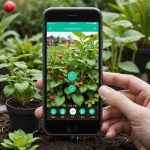Transform Your Smartphone into a Cutting-Edge Garden Guardian: An In-Depth Guide to Smart Gardening
In the era of smart homes and automated living, it’s no surprise that gardening has also embraced the wave of technological innovation. Smart gardening is revolutionizing the way we care for our plants, making it more efficient, sustainable, and enjoyable. Here’s a comprehensive guide on how to transform your smartphone into a cutting-edge garden guardian.
Understanding Smart Garden Technology
Smart garden technology integrates advanced tools and techniques to simplify plant care and enhance productivity. At its core, it leverages smart devices and smartphone integration to automate tasks such as watering, lighting, and monitoring soil conditions. This approach not only conserves time and resources but also optimizes plant growth by providing precise conditions[1].
Topic to read : Maximize Your Smartphone for Instant Traffic Notifications: Receive Real-Time Updates Like a Pro!
“Smart gardening is a game-changer for gardeners of all experience levels,” says a gardening enthusiast. “It makes plant care more efficient and accessible, even in small spaces.”
Key Components of a Smart Garden System
A typical smart garden system comprises several essential components that work together to create a seamless and efficient gardening experience.
This might interest you : Unlocking Smart Watering Solutions: The Comprehensive Handbook to Smartphone-Driven Home Irrigation Systems
Smart Sensors
Smart sensors are the backbone of any smart garden system. These devices monitor soil moisture, temperature, light intensity, and humidity, providing real-time data that helps you respond quickly to your plants’ needs. For instance, the WANFEI smart sensor can be injected into the soil to track vital metrics and send data directly to your smartphone via Bluetooth[3].
Automated Watering Systems
Automated watering systems are designed to deliver precise hydration, conserving water and promoting plant health. Devices like the Eve aqua and IRRIGOLD systems allow you to manage sprinkler systems or pot watering, establishing schedules that optimize the process. These systems can even delay watering based on weather forecasts, ensuring your plants receive the right amount of water at the right time[3][4].
Intelligent Lighting Systems
Intelligent lighting systems mimic natural sunlight, which is crucial for photosynthesis and growth, especially in areas with limited natural light. These systems can be adjusted based on the specific needs of your plants, ensuring they receive the optimal amount of light throughout the day.
Recommended Apps for Smart Garden Management
Innovations in gardening apps have transformed the way we manage our smart gardens. Here are some top apps that have garnered positive user reviews for improving gardening practices.
Gardena Smart System
The Gardena Smart System offers seamless integration with a variety of smart devices. This app tracks real-time conditions, controls watering schedules, and adjusts lighting systems effortlessly. It can alert you to soil moisture levels and forecast weather changes, keeping your plants healthy[1].
Parrot Flower Power
The Parrot Flower Power app stands out due to its advanced analytics and customization options. It provides AI-driven insights into plant health, predicting potential problems before they escalate. This app is particularly useful for gardeners who want detailed care tips tailored to their specific plant species and environmental conditions[1].
Step-by-Step Installation and Configuration
Installing and configuring your smart garden system is easier than you think. Here’s a step-by-step guide to get you started.
Preparing Your Garden Environment
Ensure your garden is within range of a reliable WiFi connection, as this will be crucial for the functionality and integration of smart devices. Your chosen smart garden tools, including sensors, lighting systems, and watering modules, should have all necessary components and user manuals for reference[1].
Setting Up Devices
Begin the setup process by strategically placing your sensors in areas where soil moisture and temperature readings will be critical. Next, install the automated watering systems, connecting them to a water source and positioning the device to optimally water your plants.
Connecting Devices to Your Smartphone
Connecting devices to your smartphone is essential. Typically, this involves downloading the manufacturer’s app and adding devices via Bluetooth or a WiFi connection. Make sure to follow the app’s prompts for installation guides and specific configurations[1].
Configuring Your Smart Garden System
Setting up your smart garden system effectively requires thorough attention to configuration details. Here are some key steps to ensure your system works harmoniously.
Initial Configuration Tips
Begin by exploring initial configuration tips, which include correctly pairing devices with your smartphone app. This foundational step facilitates seamless communication and management. Ensure your smart sensors, lighting systems, and watering tools are correctly aligned to the app’s interface, enabling automatic reporting and adjustments based on real-time data feedback[1].
Personalizing Notifications and Alerts
Personalizing your app for specific notifications and alerts is paramount. Custom alerts for soil moisture levels, temperature changes, or water schedules should be accurately set, allowing you to address urgent issues promptly. This proactive measure contributes significantly to maintaining optimal conditions for plant growth.
Saving Time and Resources with Smart Garden Systems
One of the most significant advantages of smart garden systems is their ability to save time and resources.
Automated Watering
Smart irrigation systems eliminate the need for manual watering by using sensors to detect soil moisture levels. These systems ensure that your plants receive the right amount of water at the right time, preventing overwatering and underwatering. For example, devices like the Rachio Smart Sprinkler Controller can be programmed to follow weather patterns, further optimizing water usage[4].
Remote Monitoring and Control
With smart garden systems, you can monitor and control your garden from anywhere using your smartphone. Whether you’re on vacation or stuck at work, you can adjust watering schedules, check plant health, or receive alerts about potential issues.
AI-Powered Plant Care
AI-powered plant health monitoring identifies issues like pests or nutrient deficiencies. These systems analyze data trends and provide customized advice based on your specific plant species and environmental conditions. They can predict potential problems before they escalate, helping you keep your plants healthy with minimal effort[4].
Popular Smart Garden Systems
If you’re considering investing in a smart garden system, here are some top-rated options to explore:
| System | Key Features | Ideal For |
|---|---|---|
| Gardyn Home Kit | AI-powered plant monitoring, built-in hydroponics | Indoor gardens, small spaces |
| Rachio Smart Sprinkler Controller | Weather-based watering schedules, integration with smart home platforms | Outdoor gardens, large spaces |
| Click and Grow Smart Garden | Automated watering and lighting, compact design | Small-scale gardening, indoor use |
| Netro Smart Sprinkler | Water conservation with real-time weather data, easy installation | Outdoor gardens, water-conscious users |
| AeroGarden Harvest | Automated lighting and nutrient delivery, compact indoor gardening system | Indoor gardening, year-round use |
Smart Gardening Solutions for Small Spaces
Smart gardening offers creative solutions for maximizing greenery in limited areas.
Vertical Smart Gardens
Vertical gardens transform small spaces by growing plants upward. Living walls with automated irrigation, smart trellises that track plant health, and stackable planters with sensors are all great options. These solutions are perfect for small balconies, turning empty walls into lush, productive gardens[5].
Soil Monitoring Tools
Soil monitoring tools measure nutrients, pH, and moisture, helping gardeners with large plots fertilize and water easily. These tools connect to apps, offering data-driven insights to improve soil health and plant growth. In small gardens, these tools can still be valuable by optimizing limited soil volumes, ensuring plants get exactly what they need[5].
The Benefits of Smart Gardening
Smart gardening is not just about technology; it has several benefits that can enhance your life and the health of your plants.
Sustainability
Smart gardening promotes sustainability by reducing water usage, supporting biodiversity, and minimizing waste. Automated irrigation systems and smart sensors ensure that resources are used efficiently, making it a more environmentally friendly way to garden[5].
Mental Health
Gardening has long been recognized for its mental health benefits. Smart gardening makes it easier to maintain a garden, reducing stress and increasing the sense of accomplishment. Being connected to nature, even in small ways, can have a profound impact on mental well-being.
Community and Social Media
Smart gardening can also connect you with a wider community. Sharing tips and experiences on social media platforms can inspire others and provide valuable insights into different gardening practices. Joining smart gardening groups can make the experience more enjoyable and informative.
Practical Tips and Advice
Here are some practical tips to make the most out of your smart garden:
- Choose Compatible Devices: Ensure that all your smart garden devices are compatible with your existing IoT gardening setup and your smartphone. This will make integration smoother and more efficient[1].
- Monitor Regularly: Regularly check the app for real-time information on soil moisture, light intensity, and temperature. Act on these insights by adjusting watering schedules, repositioning plants for better light exposure, or modifying the growing environment as needed[2].
- Personalize Your Settings: Personalize your app for specific notifications and alerts. Custom alerts for soil moisture levels, temperature changes, or water schedules should be accurately set to address urgent issues promptly[1].
- Consider Energy Efficiency: When selecting smart garden devices, consider energy efficiency. Devices with low power consumption can save you money in the long run and are more environmentally friendly[1].
Transforming your smartphone into a cutting-edge garden guardian is a simple yet powerful way to enhance your gardening experience. With the right smart devices, apps, and configurations, you can create a garden that is not only healthier but also more sustainable and efficient.
As you embark on this smart gardening journey, remember that it’s all about making your life easier and your garden healthier. Whether you’re in North America, South America, or anywhere else in the world, smart gardening can be adapted to your specific climate and needs.
So, take the first step today. Dive into the world of smart gardening, and watch your plants thrive like never before. Happy gardening











